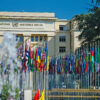“Whether in Dearborn, Paris, Zanzibar or Bangalore, approaches, projects and knowledge resources are emerging everywhere that could benefit all parts of the Ummah.”
(it). It is early. The very first daylight is asserting itself against the night. Shortly after the call to morning prayer, the worshippers make their way over the steep cobblestones to one of the district’s colourful mosques. They wear caftans, sarongs and many the uniforms of their respective working lives.
This scene does not take place in Chefchaouen, Erzurum or Bandung. Our fictional viewer is standing drowsily in the steep streets of Bo-kaap, the traditionally Muslim district of Cape Town. In the immediate vicinity of the old alleys and their colourful houses are half a dozen mosques and here are also buried some Awliya whose graves have been lovingly tended and protected by the local residents for almost 200 years.
Many such moments from our lives can be found in the world. They can be students at Zaytuna College in Berkeley, California, bending over basic texts on legal methodology. Or arriving guests on their way to a Moroccan wedding party in Herne, North Rhine-Westphalia, when they are urgently looking for a parking space so as not to be late. And sometimes it is a prayer for the dead, during which a deceased person is laid to rest on the Philippine Island of Mindanao.
Currently, of the approximately 1.8 billion Muslims around the world, almost a quarter (or 400 million) live with the status of belonging to a “minority.” They are a larger group than their brothers and sisters in the Middle East, North Africa, Indonesia, Central Asia or sub-Saharan Africa. And thus, minoritarian Muslims as a whole, quantitatively speaking, constitute the most important element.
Although we must assume different sub-categories due to their diverse conditions and history, one thing is clear: neither in the internal nor in the external perspective, nor in the framework of international Muslim bodies such as the OIC, do they and their communities play a corresponding role.
This is a pity, because the diversity and colourfulness of the Muslim world community is not only found in what is commonly understood as the “Islamic world,” but also at its “margins.” This is about much more than just “colourfulness” or representation. Whether in Dearborn, Paris, Zanzibar or Bangalore, approaches, projects and knowledge resources are emerging that could benefit all parts of the Ummah.











